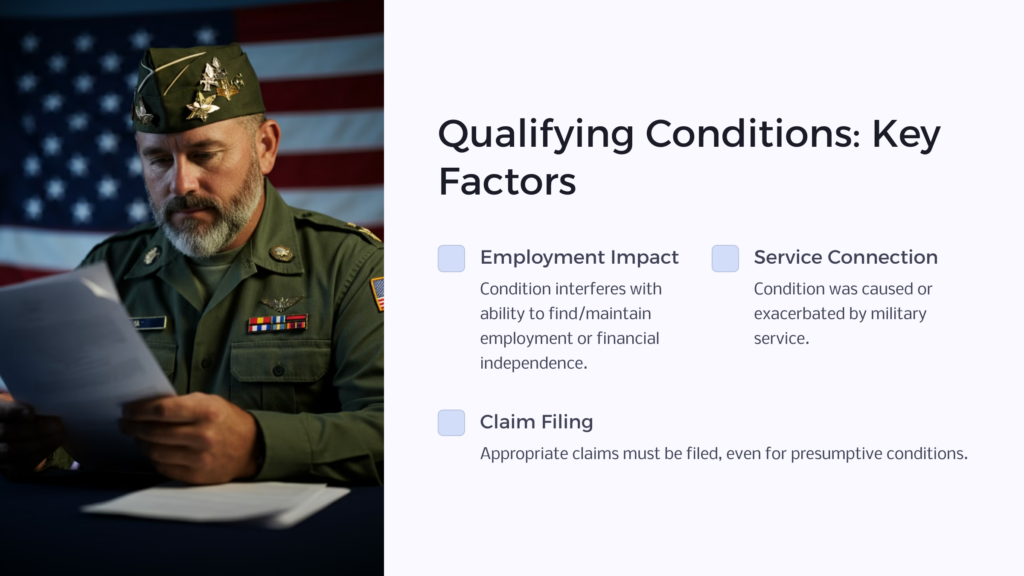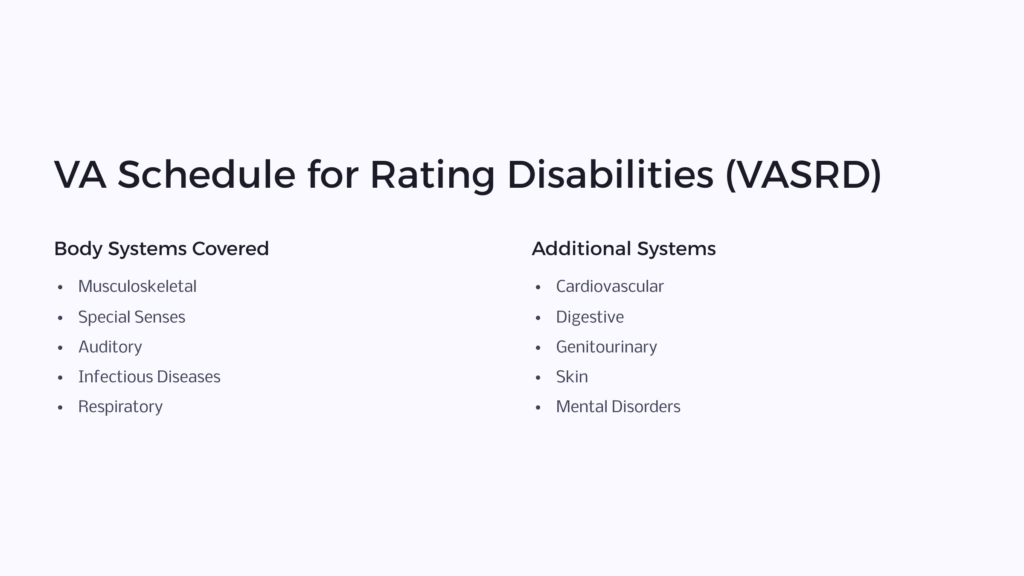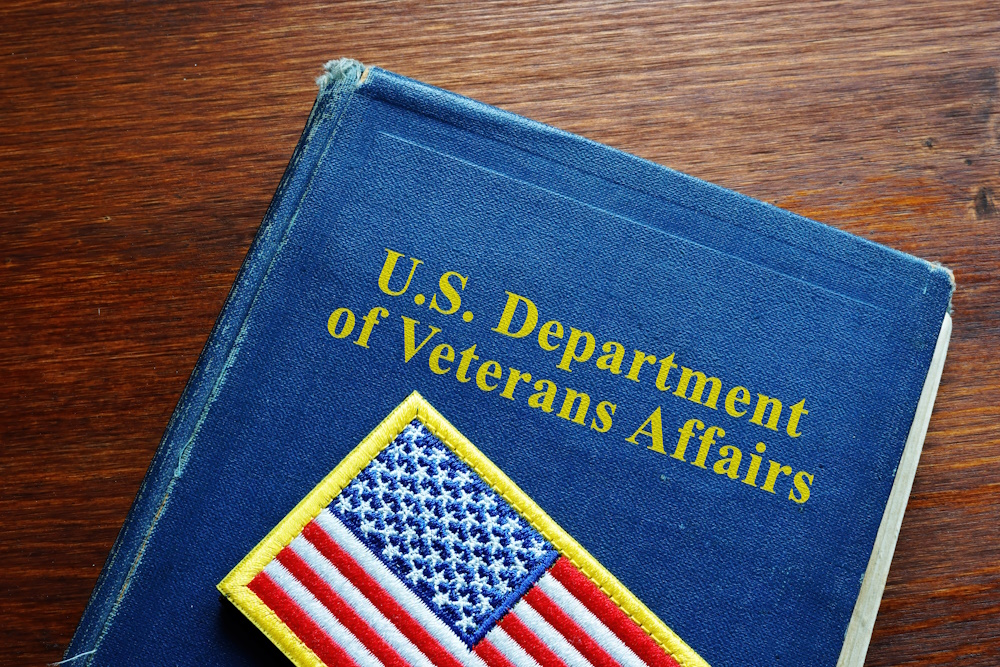Like any bureaucratic system, there’s a fair amount of paperwork involved in filing a claim to the VA for disability benefits. With that in mind, we can certainly understand if you are hesitant to spend your time and energy on preparing, filing, and awaiting a verdict for a claim if it might be doomed from the start.
So, let’s talk about it. What conditions qualify for VA benefits? What limitations or requirements are involved? Are there any disabilities that are automatically qualifying conditions? We’ll take a closer look at these and similar questions. That way, you can have a solid idea of the shape of the battlefield, as it were.
What Does the VA Count as a Qualifying Condition?

Before we go listing off dozens of incredibly specific medical diagnoses, we need to clarify a few things.
First and foremost, for a veteran to be awarded benefits, they have to file the appropriate claims. This is true no matter what their condition is, or how easy it is to prove that it’s service connected. So in that sense, there’s no condition that will give you immediate access to disability benefits. There will be some processing time involved no matter what you do, so keep that in mind.
Second, and related to the previous point, every claim has to be evaluated and assigned a disability rating. That rating is then used to determine the benefits that the veteran will receive from the VA. This is a large part of why even “presumptive conditions” (more on those later) have to be filed as a claim, and why it can take some time for the VA to return with a verdict on said claim.
Third, when we talk about what “qualifies” for VA benefits, we’re talking about two key characteristics, which can be identified by answering the following questions:
- Is the condition interfering with the veteran’s ability to find and maintain employment or financial independence in some way?
- Is the condition “service-connected,” meaning it was either caused or exacerbated by the veteran’s time in the service?
In this sense, a condition that “automatically qualifies” is simplifying the process of answering in the affirmative for one or both of those questions.
With that out of the way, let’s start discussing specifics of qualifications and disabilities.
Medical Conditions That Qualify for Disability Benefits

The VA bases its rulings for disability claims on the VA Schedule for Rating Disabilities (VASRD). This document outlines the list of currently recognized (or most commonly recognized) diagnoses that qualify for disability benefits, and how these conditions will be rated to determine benefit amounts.
The document linked above is lengthy, and not terribly user-friendly to navigate, and covers a very extensive number of diagnoses. Because of this, we’ll primarily be listing the categories here, rather than individual conditions.
Below, you’ll find that list, in the order they appear in the VASRD. Each list item is a system of the body, with conditions that affect a given system falling under the scope of that section.
- The musculoskeletal system: muscles, bones, ligaments, tendons, and basically anything involved in movement and range of motion.
- The “Organs of Special Sense”: a fancy way of referring to eyes and eyesight.
- Auditory acuity: any conditions that affect and impair hearing.
- Infectious diseases, immune disorders, and nutritional deficiencies: this section includes basically everything we label an “illness” in the traditional sense.
- The respiratory system: issues that impair or interfere with your ability to breathe and maintain healthy blood oxygen levels.
- The cardiovascular system: anything that deals with the heart, arteries, or veins.
- The digestive system: any conditions that affect the consumption, processing, and absorption of nutrition (as well as the body’s response to said nutrition).
- The “genitourinary” system: a less crass way to refer to the reproductive and waste systems of the body.
- Gynecological conditions and “disorders of the breast”: similar to the previous category.
- The hemic and lymphatic systems: all the stuff inside and attached to the stuff in the cardiovascular system, like lymph nodes, blood, and blood-generating tissue.
- The Skin: it’s…well, exactly what it says on the tin.
- The endocrine system: the systems of the body that create, regulate, and distribute hormones.
- Neurological conditions and convulsive disorders: diagnoses that cover issues with the brain, specifically those tied to how the brain physically operates, like seizures, tumors, TBIs, and so forth.
- Mental disorders: similar to the previous category, but focused on the aspects tied to hormone-managed performance, like depression, PTSD, and other mental health issues.
- Dental and oral conditions: this final category concerns the mouth, teeth, and otherwise anything involved with how resources enter the body.
So, obviously there are quite a few conditions that can qualify. But actually qualifying is another matter.
Factors That Affect Qualification
It’s important to note that, while the category list is pretty comprehensive, the conditions listed under each umbrella are not. Just because a condition affects, say, the skin, isn’t a guarantee it will qualify for VA benefits.
As mentioned above, the VA evaluates conditions based on how they impact your daily life, especially where it concerns your ability to earn a living. The more disruption a condition causes, and the harder it is to work a job and care for yourself, the higher the rating. The reverse is also true, with less disruptive conditions resulting in less disability support.
Conditions also have to be service-connected, meaning that you wouldn’t have it (or it would be much less severe) if you had never served in the military.
In other words, even if you have a qualifying condition, if it’s not sufficiently disruptive, or you can’t provide verification of how it’s service-connected, it won’t qualify you for benefits.
Certain factors may also make it easier or harder to prove a condition’s service-connected status. Your age, your time of service, what you did or experienced while on duty, and other factors can affect how much evidence you need to provide to the VA for your claim.
And, on a related note, some veteran demographics and some conditions are treated as service-connected by the VA by default.
Presumptive Disability Benefits
The VA has an entire list of situations where the link between a veteran’s service and specific diagnoses. As a very high profile example, veterans who were exposed to Agent Orange are at significantly higher risk of certain conditions, and the VA often takes the service connection for granted as a result.
When a veteran’s time of service, experiences, or timeline of condition status basically prove service connection on their own, it’s known as a “presumptive condition” or “presumptive service connection.” In these cases, a veteran may need very little (if any) supporting evidence for their claim. Here are some examples:
- The veteran served during a particular war or military operation
- The veteran was a former prisoners of war
- The veteran received a diagnosis of a chronic disease within a year of discharge from active duty
These are, perhaps, the closest thing to “automatically qualifying disabilities.” You’ll still need to file a claim as usual, with all that entails. As a matter of fact, you may still need to prove that the condition is interfering with your ability to perform normal, everyday tasks.
For certain presumptive conditions, a veteran may not even need to provide evidence of how the condition results in a disability. But that isn’t always the case, and not every condition is deemed a disability by the VA. Basically, it’s hard to offer any guarantees here, and it would be misleading if we did.

Conclusion
Your time in the service likely presented you with numerous situations where you were exposed to greater risks to your physical and mental health. For those who return home “scarred” in one form or another, there is assistance available to you. Some situations may have an easier time establishing the vet’s needs and qualifications, but nothing is automatic.
It would seem, even after your discharge, you’ll likely be asked to “hurry up, and wait.”
If you’d like help getting started, or are looking for additional support while you deal with the waiting, we’re here for you. Visit benefits.com to take our quiz to learn how we can help in your particular situation.
 Benefits.com Advisors
Benefits.com Advisors
With expertise spanning local, state, and federal benefit programs, our team is dedicated to guiding individuals towards the perfect program tailored to their unique circumstances.
Rise to the top with Peak Benefits!
Join our Peak Benefits Newsletter for the latest news, resources, and offers on all things government benefits.



















